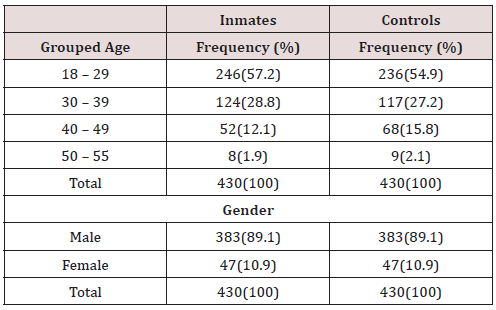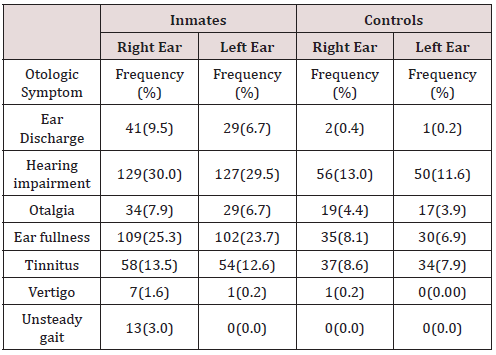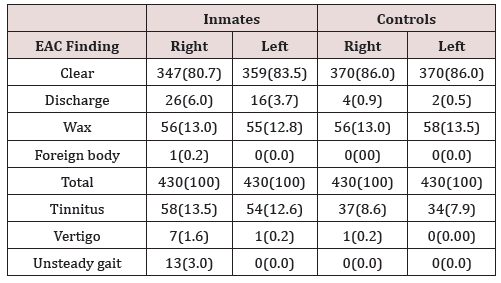
Lupine Publishers Group
Lupine Publishers
Menu
ISSN: 2641-1709
Research Article(ISSN: 2641-1709) 
Cross-Sectional Study of Cerumen Impaction Among Inmates of a Nigerian Correctional Facility Volume 6 - Issue 1
Abdullahi Musa Kirfi1*, Mohammed Bello Fufore2, Oladeji Raheem Quadri3, Musa Emmanuel4, Aliyu Mohammed Kodiya5 and Onyekwere George Benjamin Nwaorgu6
- 1Department of Otorhinolaryngology & Head and Neck Surgery, Abubakar Tafawa Balewa University Teaching Hospital Bauchi, Nigeria
- 2Department of Otorhinolaryngology & Head and Neck Surgery, Federal Medical Center Yola, Nigeria
- 3Department of Otorhinolaryngology & Head and Neck Surgery, Gombe State University, Gombe Nigeria
- 4Department of Otorhinolaryngology & Head and Neck Surgery, Maitama District Hospital, Federal Capital Territory Administration, Nigeria
- 5Department of Otorhinolaryngology & Head and Neck Surgery, University of Maiduguri and University of Maiduguri Teaching Hospital, Nigeria
- 6Department of Otorhinolaryngology & Head and Neck Surgery, University of Ibadan and University College Hospital, Nigeria
Received: February 01, 2021 Published: February 10, 2021
Corresponding author: Abdullahi Musa Kirfi, Department of Otorhinolaryngology & Head and Neck Surgery, Abubakar Tafawa Balewa University Teaching Hospital Bauchi, Bauchi Nigeria
DOI: 10.32474/SJO.2021.06.000227
Abstract
Background: Prisoners are prone to many diseases and their complications. In most countries, prisoners are neglected, so also their ear health. This study aimed to determine the pattern and prevalence of wax impaction among inmates of a prison in Kaduna Nigeria.
Participants and Methods: This was a cross-sectional study of prison inmates at the Kaduna convict prison and a control population. All consented inmates aged 18 – 55years in the Kaduna convict prison were enrolled. Equal number of controls matched for age and gender were enrolled from the communities in Kaduna North Local Government. Data was collected using a structured questionnaire. Participants had thorough physical examination of the ear as well as otoscopy to assess the external auditory canal for presence of impacted wax. Statistical Product and Service Solutions (SPSS) version 20.0 was used to analyse the data. Test of significance was conducted with chi square test.
Results: Four hundred and thirty inmates and equal number of controls matched for age and gender were enrolled for the study. The mean age for the inmates and controls were 29.7±8.1 years and 30.47±8.02 years respectively. In both groups 47 females and 383 males were enrolled, with a F:M of 1:8.1. Prisoners had wax impaction in 56 (13.0%) right ears and 55(12.8%) left ears while the general population had wax impaction in 56(13.0%) and 58(13.5%) right and left ears, respectively.
Conclusion: Wax impaction showed no preponderance between the inmates and the general population.
Keywords: Prison inmates; prevalence; ear canal; wax impaction
Introduction
Major studies on health of prison inmates were undertaken in developed countries but there is paucity of data on health of prisoners in the developing world [1]. Excessive secretion of ceruminous glands, narrow external auditory canal may result in the accumulation of wax (Cerumen) which may give rise to symptoms of discomfort, ear fullness, itchiness of the ears, tinnitus, and variable degrees of hearing loss [2,3]. Without regular checkups in the prisons, the cerumen will not be diagnosed, and hence remain untreated. The external auditory canals may also harbor fungal infections [4] thereby giving the individuals a sense of aural blockage and sometimes otalgia. Other symptoms associated with wax impaction are tinnitus, aural fullness, and hearing loss [5]. Globally, there is paucity of data in the English literature about the ear health of prison inmates hence comparison with the global community will be difficult. We aimed to determine the prevalence and pattern of wax impaction among prison inmates of the Kaduna convict prison.
Participants and Methods
This was a cross-sectional study of prison inmates at the Kaduna convict prison. Ethical approval was obtained from the Kaduna State Ministry of Health and the National Headquarters of the Nigerian Prison. Sample size for the study was calculated using the Fischer formula for cross-sectional studies, minimum sample size calculated as 384. Four hundred and thirty prison inmates and similar number of controls were enrolled for this study. The selection of the subjects was done by simple random sampling while the controls were selected by convenient sampling. At the time of first visit, there were two thousand and fifty-six inmates consisting of one thousand and six convicted and one thousand and fifty inmates awaiting trial in the Kaduna convict prison. All consented inmates aged 18–55years in the Kaduna convict prison were enrolled. Equal number of controls matched for age and gender were enrolled from the communities in Kaduna North Local Government. Data was collected using a structured questionnaire. Participants had thorough physical examination of the ear with headlight as well as otoscopy to assess the external auditory canal for presence of ear wax. The diagnosis of ear wax was made when the wax obscured the view of the tympanic membrane (irrespective of whether its impacted or not). Those with impacted wax in their ear canals had it removed by either manual (using Cawthorne wax hook and/or Jobson-Horne aural probe) or by gentle ear syringing after applying some cerumenolytic agents. Statistical Product and Service Solutions (SPSS) version 20.0 was used to analyze the data. Test of significance was conducted with chi square test at p-value of < 0.05.
Results
Four hundred and thirty prison inmates and an equal number of individuals matched for age and gender were enrolled for the study. The mean age for the inmates and the controls were 29.7±8.1 years and 30.47±8.02 years, respectively. In both groups 47 females and 383 males were enrolled, with a F:M of 1:8.1. Table 1 below shows the demographic characteristics of the participants during the study period. Both the inmates and the general population had some otologic symptoms during the study period. However, the symptoms are by no means exhaustive. Table 2 below showed the distribution of symptoms by both the inmates and the control population. Chi square test revealed a statistically significant difference between subjects and controls for ear discharge (χ2=44.932, p=0.0001). Otalgia was recorded in 46 (10.7%) of inmates and 21 (4.9%) of the controls (χ2=10.117, p=0.0001).One hundred and twenty-three (28.6%) inmates and 36(3.4%) controls complained of aural fullness (χ2=58.401, p = 0.0001). There was a significant statistical difference between inmates and controls who complained of noise in the ear (χ2=10.843, p = 0.001). Table 3 below showed the examination findings of the external auditory canals among both the inmates and the control population. The general population was shown to have more wax impaction in their left external ear canal 58/430 (13.5%) compared to the prison inmates 55/430 (12.8%), but the difference was not statistically significant.
Discussion
In this study, four hundred and thirty prison inmates in the Kaduna convict prison had evaluation with history, physical examination and then compared with the same number of participants in the general population within Kaduna metropolis. The mean age of the inmates was 30.2±7.51 years compared with 30.4±8.02 years for the general population. In both the inmates and the general population, majority of the participants were between 18–29 years. This corresponds to the agile members of most communities. Wax impaction was the most frequent finding during otoscopy among both the inmates and the controls. Otorrhoea was seen in 42 (4.9%) ears among the inmates while 6 (0.7%) were recorded among the controls. Wax impaction in the external ear canal was a common finding in the ears of the general population [2,6,7]. The participants had their ear wax removed by the use of Jobson-Horne probe or wax hook. Some participants had wax removal effected via gentle ear syringing. Ear syringing has been identified as a safe procedure for the removal of ear wax [5,8]. In this study, there was not much difference in the rate of wax impaction between the inmates and the general population.
Conclusion
Cerumen impaction was a common finding among both the inmates and the general population. Regular health talk on aural hygiene and periodic ear assessment of prison inmates and the general population will ensure a better outcome.
References
- Thomas R, Job A (2009) Hearing Loss among Prison inmates in India–a pilot study. Indian J Otolaryngol Head Neck Surg 61: 105-108.
- Adoga A, Bakari A, Kodiya AM, Ahmad B (2010) Cerumen auris: a survey of its management at the National ear care centre, Kaduna Nigeria. Internet Journal of Otorhinolaryngology 12(1): 9544.
- Kirfi AM, Mainasara GM, Saidu AT, Fufore MB, Joseph Y (2014) Cerumen auris in Abubakar Tafawa Balewa University teaching hospital Bauchi, North-eastern Nigeria. Sudan Med Monit 9: 75-80.
- Oyeka CA, Eze II (2007) Fungal skin infections among prison inmates in Abakaliki, Nigeria. Mycoses 51: 50-54.
- Kirfi AM, Fufore MB, Samdi MT, Salisu AD (2019) Wax Impaction among School Children Aged 7-17 Years in Kaduna Metropolis, Kaduna, Nigeria. Otolaryngol (Sunnyvale) 9(4): 376.
- Gabriel TO (2015) Cerumen Impaction: Challenges in Management Profile in a rural health facility. Nig Med J 56: 390-393.
- Charlie M, John M (2018) Cerumen Impaction: Diagnosis and Management. Am Fam Physician 98: 525-529.
- Seth RS, Anthony EM, Richard MR, Bopanna BB, Jesse MH, et al. (2017) Clinical Practice Guideline (Updated): Otolaryngol Head Neck Surg 156: 1-29.

Top Editors
-

Mark E Smith
Bio chemistry
University of Texas Medical Branch, USA -

Lawrence A Presley
Department of Criminal Justice
Liberty University, USA -

Thomas W Miller
Department of Psychiatry
University of Kentucky, USA -

Gjumrakch Aliev
Department of Medicine
Gally International Biomedical Research & Consulting LLC, USA -

Christopher Bryant
Department of Urbanisation and Agricultural
Montreal university, USA -

Robert William Frare
Oral & Maxillofacial Pathology
New York University, USA -

Rudolph Modesto Navari
Gastroenterology and Hepatology
University of Alabama, UK -

Andrew Hague
Department of Medicine
Universities of Bradford, UK -

George Gregory Buttigieg
Maltese College of Obstetrics and Gynaecology, Europe -

Chen-Hsiung Yeh
Oncology
Circulogene Theranostics, England -
.png)
Emilio Bucio-Carrillo
Radiation Chemistry
National University of Mexico, USA -
.jpg)
Casey J Grenier
Analytical Chemistry
Wentworth Institute of Technology, USA -
Hany Atalah
Minimally Invasive Surgery
Mercer University school of Medicine, USA -

Abu-Hussein Muhamad
Pediatric Dentistry
University of Athens , Greece

The annual scholar awards from Lupine Publishers honor a selected number Read More...







